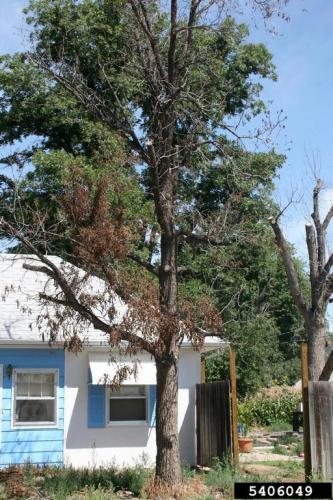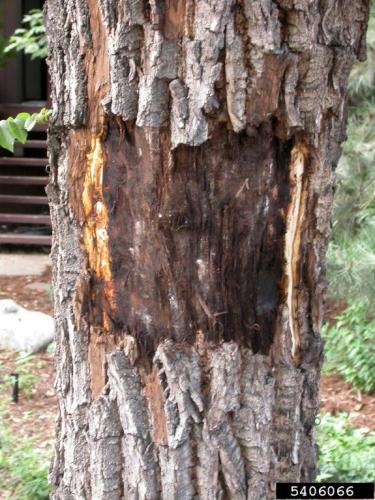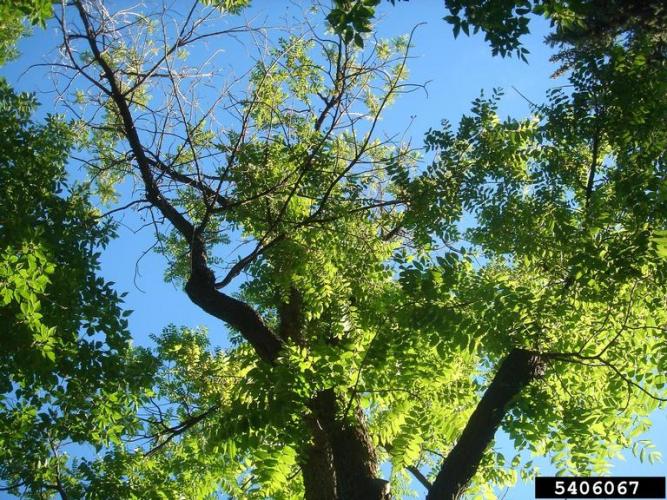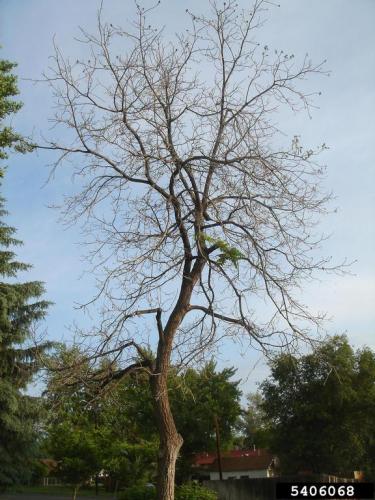Thousand Cankers Disease
Identification
The Thousand Cankers Disease (TCD) is a destructive pest complex consisting of an insect pest, the Walnut Twig Beetle (Pityophthorus juglandis), which is a vector for the fungal pathogen, Geosmithia morbida sp. nov. The beetles feed on young branch tissue, preferably wood larger than 2cm, in the upper canopy early in the spring. Later in the summer, adults move into the lower trunk to overwinter. Adult bark beetles introduce fungal spores into the phloem when they construct galleries. The fungus causes small “cankers” by killing the inner bark around the galleries. These cankers may enlarge and coalesce to completely girdle the branch. The cumulative effect of “thousands” of coalescing cankers eventually kills the tree.
Eastern black walnuts (Juglans nigra), butternut (Juglans cinerea), and other walnut species native to the western U.S. are susceptible to the disease and have sustained mortality. There appears to be a range in susceptibility of Juglans species to theGeosmithia fungus. Black walnut is a very susceptible host, with large cankers developing in response to inoculation. Other species, including Arizona walnut (Juglans major) and little walnut (Juglans microcarpa), species native to the western U.S., develop more restricted cankers following artificial inoculation.
signs and symptoms
The three major symptoms of this disease are:
- branch mortality
- numerous small cankers on branches and the bole
- evidence of tiny bark beetles
The dominant symptom is that branches fail to leaf out in the spring. Branches may leaf out very weakly in the spring or, more rarely, die anytime during the summer. The earliest symptom is yellowing foliage and thinning of the upper crown that progresses rapidly to brown wilted foliage, then finally branch mortality. Dieback always appears to start in the upper crown and progresses to lower branches in succeeding years.
The fungus causes distinctive circular to oblong cankers in the phloem under the bark, which eventually kills the cambium. In comparison, cankers of the Butternut Canker Disease are elongated sunken cankers that tend to originate at leaf scars and buds. They have an inky black center with a whitish margin.
For both diseases the bark surface may have no symptoms, or a dark amber stain or cracking of the bark may occur directly above a canker. To find cankers, carefully remove the bark from symptomatic limbs. When peeling the bark, do not cut too deeply as the beetle galleries and fungi of TCD are found in the living bark (cork cambium and not the wood cambium). Individual TCD cankers may at first be only a few millimeters in diameter, but ultimately can be 3 cm or greater (1” +) and have an elongated oval shape. Typically the appearance of a shallow tunnel produced by the walnut twig beetle will be present near the center of the canker. Many small, dark, dead areas (cankers) can be found under the bark of heavily infected trees.
Numerous pin-sized bark beetle entrance and exit holes are visible on dead and dying branches, and bark beetle galleries are often found within the cankers. In the final stages of the disease, even the main stem has beetle attacks and cankers.
See image slideshow above for signs and symptoms.
Biology
Origin
The walnut twig beetle (WTB) is native to California, the southwestern U.S., and Mexico, where its original hosts were western black walnut or Arizona walnut trees. TCD was first observed in New Mexico in the 1990’s. Eastern black walnut and English walnut trees have been planted extensively in the west since the 1850’s, which increased the number of hosts for the WTB and permitted a range expansion of the beetle into additional western states.
Life Cycle
The walnut twig beetle spends winter primarily, and possibly exclusively, in the adult stage sheltered within cavities excavated in the bark of the trunk. Adults resume activity by late-April and most fly to branches to mate and initiate new tunnels for egg galleries; some may remain in the trunk and expand overwintering tunnels. Beetle larvae feed for 4-6 weeks under the bark in meandering tunnels that run perpendicular to the egg gallery and pupate at the end of the tunnel.
Adults emerge to produce a second generation. Peak flight activity of adults occurs from mid-July through late August and declines by early fall as the beetles enter hibernation sites. A small number of beetles produced from eggs laid late in the season may not complete development until November.
Adult bark beetles carry fungal spores that are then introduced into the phloem when they construct egg galleries. Small cankers develop around the galleries; these cankers may enlarge and coalesce to completely girdle the branch. Trees die as a result of these canker infections at each of the “thousands of” beetle attack sites.
ecological threat
Mortality due to the TCD was first noticed in Colorado Springs, Colorado around 2003. The disease has since been detected around the west and is currently known to occur in California, Oregon, Washington, Idaho, Utah, Arizona, and Colorado. The disease poses a major threat to the forests of the eastern U.S. where black walnut is native. The disease was found on urban walnut street trees in Tennessee in 2010 and had most likely been present for 15-20 years. Since then it has been detected in eastern PA, NC, VA, and OH.
Vermont Distribution
Thousand Cankers Disease has never been detected in Vermont.
Citations
Photo Credit
Curtis Utley, CSUE, Bugwood.org
Whitney Cranshaw, Colorado State University, Bugwood.org



